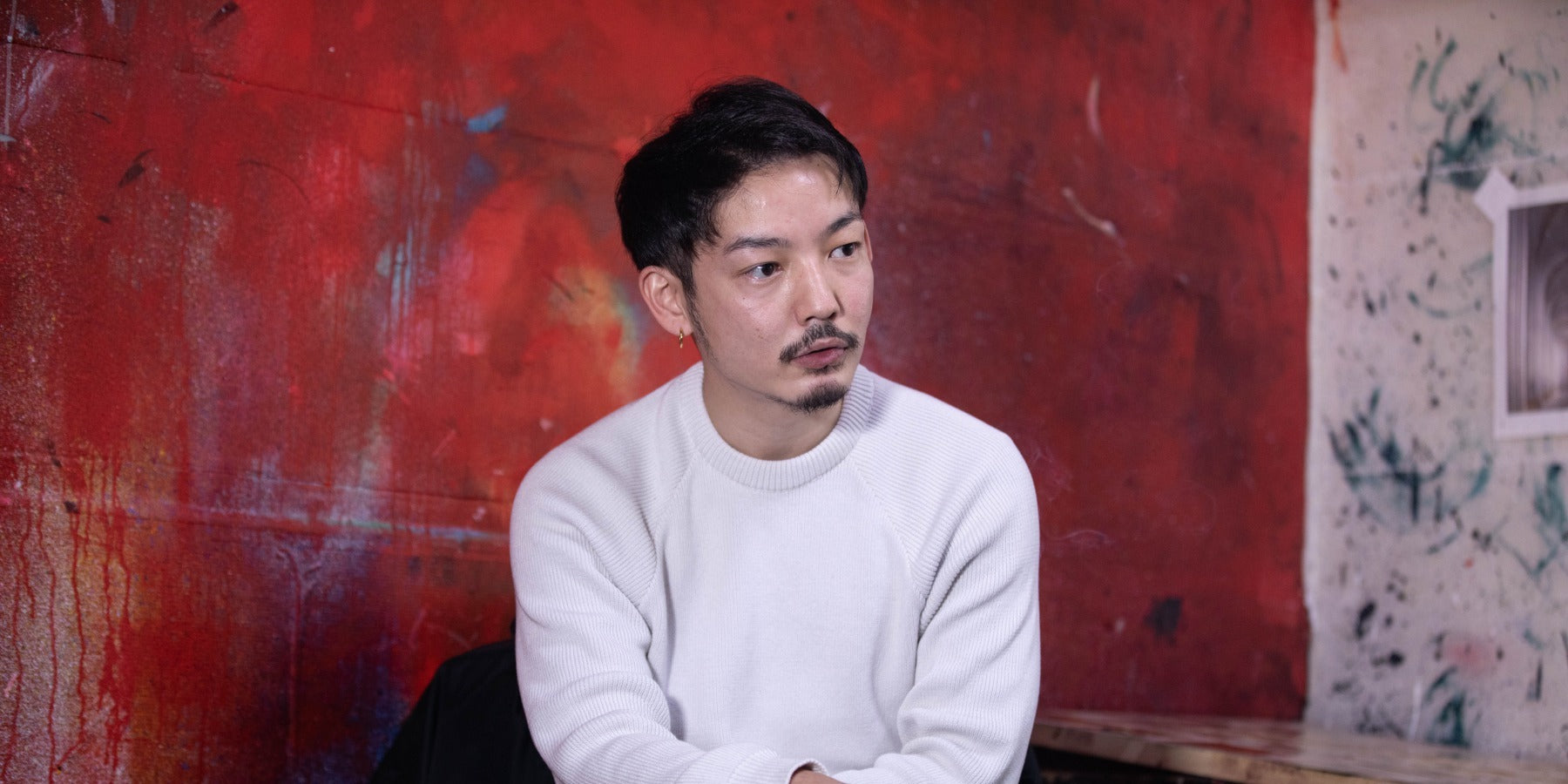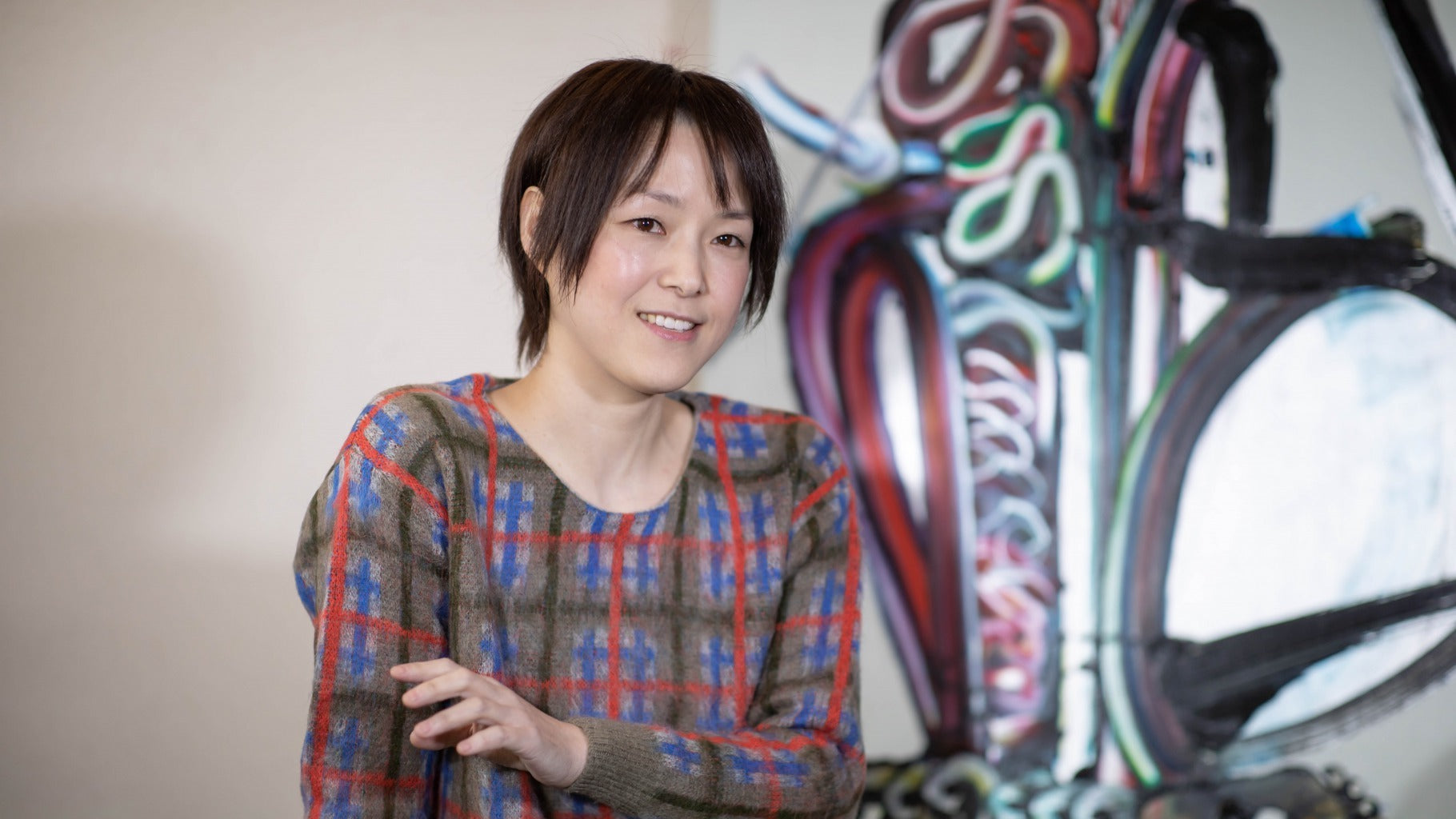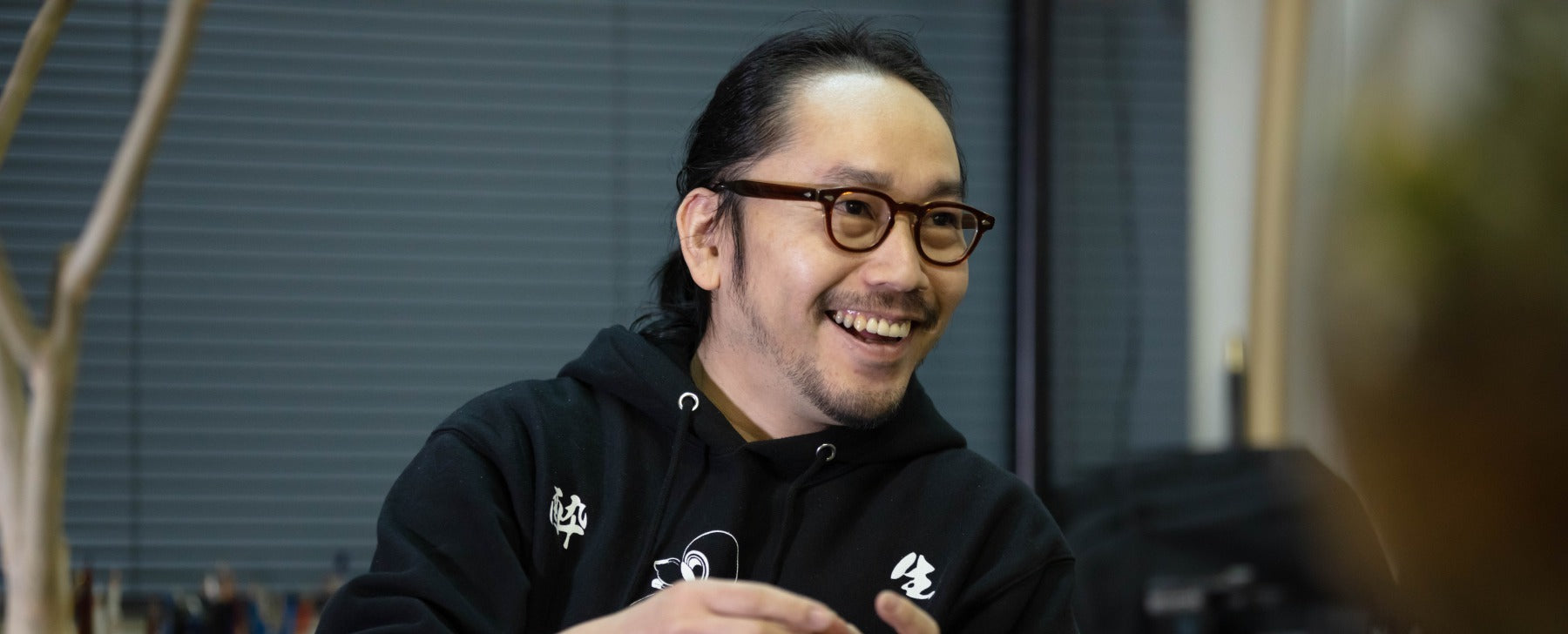
[ARTIDE After Talk②] Kosuke Motohashi
ARTIDE recently released the project's first item, ``Multi-Compact Wallet,'' through crowdfunding Makuake.
TIDE director Utsumi visited the participating up-and-coming artists and shared their feelings and memories during the process of this project, which was based on the theme of ``fusion of art and local industry,'' and at times, their true feelings leaked out. I will send you the details of the conversation.
The second person is Kosuke Motohashi. This time, we visited Mr. Motohashi's atelier and talked to him about it.
Please enjoy it together with the ARTIDE page and note (Motohashi-san interview) .
Photographer: Shuhei Kubo Interview/Composition: Keisuke Kishimoto *The interview was held in November 2020.
Index
Talk
#idling talk
Motohashi: I started drawing before I could remember, probably around the age of three. I've been drawing for a long time, but I started drawing using canvas in 2013.
Utsumi: 7 years ago!
Motohashi: In 2013, I lived in Sweden and was stationed there as an office worker. In Sweden, the sun doesn't come out all winter. From November to February, it is pitch black even during the day. At that time, I decided to become an artist and went to buy a canvas. That's what started it.
Utsumi: So it was decided at that time.
Motohashi: That's right. There aren't that many Japanese people around me, and there aren't many people around me who understand and remember my existence, so I felt that even if I died now, my life would have no meaning. I feel like that's a huge waste of my life, so I decided to turn the energy swirling inside me into a work of art and leave it somewhere other than my own body.
Utsumi: Do you feel like you've been drawing for a long time now?
Motohashi: Basically, I'm always drawing. I play around, but my mind is always thinking about art. I read books, went to see architecture, and talked with creative people in different fields, such as chefs and researchers. Recently, the person who has been most inspiring to me was Professor Hiroshi Ishiguro of Osaka University, who is developing and researching androids, and although I am working on something that is at first glance the opposite of the technology that he is involved in, I feel a great deal of sympathy for the vector of perspective that asks, ``What is life and the heart?'' and ``What is life and the heart?'' In this way, I try to follow my curiosity and absorb a lot of things, even things that at first glance seem unrelated to art.
 Mr. Kosuke Motohashi
Mr. Kosuke Motohashi
#Main story
Utsumi: Thank you for your cooperation today. Last time, I wrote a sentence on the note . I think you wrote about how you started drawing and what kind of images you usually draw. This time we will talk about the story that happened after the ARTIDE project actually started. This was our first challenge as TIDE, but I would like to hear from Mr. Motohashi about his feelings and thoughts during the process of creating it together, and his impressions after seeing the completed work.
Motohashi: Okay, thank you very much.
—— What did you think when you heard about ARTIDE?
Motohashi: I was happy! I like working with people, so I remember being really happy about this story. At the same time, I honestly thought it would be difficult to draw directly on a leather wallet (lol). Still, I was really happy.
Utsumi: I was aware of the high level of difficulty, but thank you for accepting it (lol).
Motohashi: Also, there is a history of TIDE and urban crafts, so I was drawn to that. I think it's great to create things and create synergy with people who express their ideals through leather products, even though their methods of expression are different from mine. I have read the brand story on TIDE's website many times. I agree with you that's right.
Utsumi: Thank you! Actually, I have always been mentally weak, and there were times in the past when I was really worried and depressed. That's why we incorporated our desire to turn the tide into our brand. Lately, I've been trying to talk to people about my past and present mental state by saying, ``I used to be like this, and now I'm like this.'' Many people then confess that they felt the same way. If you look around Japan, there are quite a lot of them.
Motohashi: That's right. There are times when I get so disgusted with myself that I feel like stabbing myself in the leg with a knife (lol). This may be an extreme statement, but if you do something with a strong will, you will always hit a wall.
Utsumi: That's right, the more you move, the more you hit a wall. If you overcome them one by one, things will get better little by little...that's what it feels like. I thought that this kind of mentality would be a good fit with Mr. Motohashi, so I ended up talking to him (lol).
Motohashi: TIDE's phrase "turning the tables" really appealed to me. These are words that really hit home right now during this coronavirus pandemic. That's why I feel like this is a job that has meaning for today's world and for me, and that I should do it.

—— I think you had to make full use of Zoom and chat to create things together without meeting in the situation where you had to move forward with the project due to the coronavirus pandemic. Did you find it difficult to communicate or progress, or did you enjoy it? Has that ever happened?
Motohashi: I didn't have any trouble communicating.In fact, it was refreshing and fun. What I struggled with was how to present it. I assumed that many of the people who would see this work would probably be unfamiliar with contemporary art, so it was very difficult to think about how to show something that they would enjoy. In other words, my thinking is a little more design-oriented. It was different from my usual method, so it was difficult. I thought about the person holding it, and I also thought about what it would be like to be in a lineup with four other artists. Also, I personally like black wallets, so if I wanted to draw a picture on it, it would be better on the inside. However, there was no point in simply drawing my picture on a leather wallet, so I worked on it while keeping in mind the fusion and harmony of my theme and the TIDE brand concept. Therefore, I thought about expressing the flow and movement of the tide on the front side, and expressing the human pulsation on the inside.
Inland sea: tides and human arteries. Although the flow is different, there is an affinity.
Motohashi: Macro and micro, or natural and human things. There are some things that are very linked.
—— The outside expresses nature, and the inside expresses the inner parts of humans...it's chilling in a good way.
Motohashi: Yes, that's right. Isn't it really dangerous to have that in your pocket? ?
Utsumi: That’s true, it’s dangerous! When I look at the reactions of those around me, most of the reactions come from men. Also, women who tend to have male brains also want to buy it.
Motohashi: The women around me say they want to buy more.
 At Mr. Motohashi's atelier
At Mr. Motohashi's atelier
—— You said earlier that you worked on it while imagining the person who would use it, but in what scenes, situations, and emotions did you imagine it being used?
Motohashi: I hope everyone understands and enjoys using it. However, since you are taking the trouble to hold it in your hands, I would be happy if you could understand and sympathize with the thoughts behind the work and use it. It's not just my thoughts, but the concept of TIDE and the entire history of Higashikagawa City's local industry.
Utsumi: Mr. Motohashi understands this project extremely well.
Motohashi: Things that are made in a factory or by the hands of craftsmen are not something that just happens, they are something that cannot be completed unless you put a lot of thought into it and invest time and energy into it. By realizing this, I think it will become a good experience using a wallet, and not just using a wallet.
——At the beginning, you mentioned that you drew a piece of art out of anger, but what do you usually think about when doing art?
Motohashi: What I've always been doing is, in one word, "giving form to the truth." In short, I want to give form to what is worth believing and certain for myself and others. The reason is that, from my perspective, art is a medium for understanding the world and people through visual perception. The eyes are sensors, and the brain is a program that interprets what the sensors receive. When you think about it like this, I think that art and paintings have the aspect of providing a certain way of looking at things. For example, "Duchamp's urinal". That made me realize that art is not something you see with your eyes, but something you think about. The Mona Lisa presented the common understanding that humans see distant objects as small and nearby objects as large. So, what message do I try to convey in my paintings? What I think is certain? Both creating and viewing works are about recognizing and accepting them. One of the paintings is done using splashes of paint, and the theme is ``Small things come together to make a whole.'' That is definitely a universal truth of the universe. By watching this, I hope to convey to people that ``I, too, am a person who exists through interactions with many people.''
Utsumi: It's very easy to understand and interesting. If you understand the relationship between art and pictures and the viewer, it will become much easier to enjoy art.
 TIDE Director Utsumi
TIDE Director Utsumi
Motohashi: I currently have three major series. One is a collection of small objects expressed through droplets. The second one is something I drew with my hands, an impulse. Good and bad and morals change over time, but the impulses that come from within are completely present, so I try to believe in them without classifying them as good or bad. I drew TIDE as my second series, although I drew it a little more beautifully (lol).
--The fact that it is beautifully drawn may be a sign of the awareness and consideration given to the user.
Motohashi: That's right. If you make it too conceptual, some people won't be looking for that kind of thing... I drew it with the hope that it would give people an opportunity to connect with art, even if they are not familiar with it.
Utsumi: It's also a challenge to explore the gap between art and design.
Motohashi: Yes. Also, speaking of this year...this is the third series, and it is expressed by burning paint.
Utsumi: I burned it! ? what do you mean! ?
Motohashi: First, let's talk about the story. Last time, I took oil paints and canvas to the Arakawa riverbed, lit them on fire, and the flames went up (lol). On the way, two policemen came and asked me, ``What are you doing?'' I answered, ``I'm doing art'' (lol). Even though I had a hard time reacting, he kept watching over me until the whole process was completed (lol). This work, which I painted by burning, is about bloom, the blooming of life. In 2020, I wanted to convey the message that "living is a beautiful thing." So, what living means is to continue to create oneself while ingesting energy and metabolizing it. To make things a little more complex, a scientist named Ilya Prigozhin, who won the Nobel Prize in Chemistry in 1977, discovered a structure that continues to maintain its structure only when a certain amount of input is received, and called it a "dissipative structure." The whirlpools and flames were truly dissipative structures, and at that moment I was struck by the fact that there was no boundary between life and non-life. In other words, I didn't need to use life to express life, and at that time I also realized that oil paint burns, so I immediately started burning it in my studio...and a pillar of fire as tall as myself rose up ( lol). When I hurriedly put the painting up on the balcony, the urethane foam on the balcony caught fire, and things turned into a terrible situation in this room (lol). In other words, I thought that combustion was a very appropriate way to express life, both intuitively and mechanically. To me, oil paint and canvas feel like a physical body. Then, as our bodies burn out, we gradually deteriorate as objects, but if we can create a beautiful work of art that captures the appearance and traces of that, I think we can affirm that our lives are beautiful things. That's what I thought. So, this time I expressed it by burning it.

——Not only are the episodes interesting, but the process of coming up with the themes and expressions is also very interesting. Honestly, when I heard about burning, I wondered if there was a more intuitive way to express it. I apologize for giving you such a rude impression.
Motohashi: At first, it wasn't logical. The moment I see it burn, I'm like, ``Oh, it's on fire!'' But when I have an infinite number of ideas floating around, when I have to choose which one to present to the world as an author, I find the one that is the most persuasive and believable. I choose what I can do. When I kept thinking about why I feel that burning is beautiful, and what life is, I realized that these two things were linked together and that this is the only way. That's the feeling I have in every piece. At first I didn't intend to draw it by hand at all. I had canvases lined up in front of me and was thinking of drawing in another way, but one day I got too excited and started making handprints...
Utsumi: That's amazing. It's something that comes out of trying out various things.
Motohashi: It’s fun to draw with your hands! That's what happened. Then, the next day, I felt something essential about this fun and wondered what it was all about. When you feel something really strong and want to convey it, preserve it, or prove it, drawing it with your hands is a way of reminding yourself that you are here and now. I felt that it was a direct and strong way to express that cry. I thought that this was the root of humanity, so I researched it and found out that the oldest painting that has been discovered is said to be a Neanderthal mural at La Pasiega, and it's a handprint. . In other words, before the concrete murals like the Lascaux murals, the first form of art was the print of one's own hand. Neanderthals were different from us today, but one of the most notable aspects of Neanderthal culture was the practice of offering flowers to the dead. For tens of thousands of years after hominid creatures took on human form, they did nothing but hunt and gather, but eventually they suddenly began to mourn their dead. The people who realized that their friends were going to die, and realized that they wouldn't come back after they died, and the people who started painting for the first time, were around the same time. In other words, I think it's because we realized that we are not eternal that we left something behind. I believe that the same feeling as the Neanderthal who drew that picture still exists within me, transcending eras, and I continue to draw with that feeling. It turned out to be a bit difficult... (lol)

Utsumi: The reason why you think it's fun to draw by hand is proven by the origins of how humans began drawing...that's why it's an expression that you believe in. It's really emotional.
Motohashi: ``Why do I feel this way?'' I think about the reasons by relating them to the history of painting and human culture. Also, I always feel like the work is being drawn by one of the people who lived in that era, rather than by myself. In 2020, many people were suffering due to the coronavirus pandemic, and this is a picture drawn during that time. I always have this feeling.
Utsumi: I really want to listen to you as much as I want, but my time has run out.
Thank you for today!
Motohashi: Thank you very much!

Profile
Kosuke Motohashi
Born in Hyogo Prefecture in 1989.
His works are characterized by avant-garde techniques such as splashing and bare hands, and are drawn with the Japanese sensibilities of ``mitate'' and ``Zen'', and which emphasize spirituality and meaning, mixed with philosophical and anthropological considerations. .
He views the creation and appreciation of art as a ``ritual of confirmation'' unique to humankind, and makes the expression of ``certain truth for humans'' the theme of his work.


